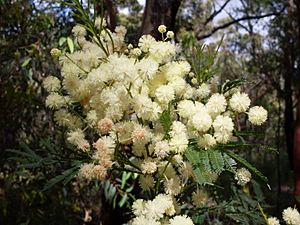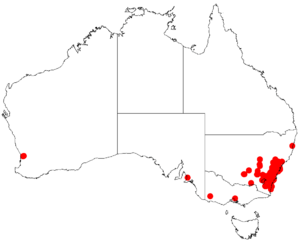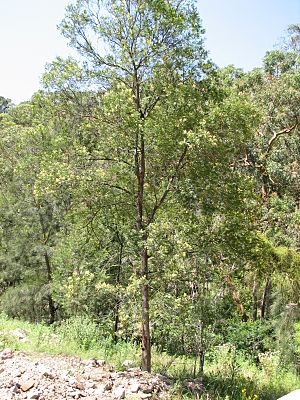Parramatta wattle facts for kids
Quick facts for kids Parramatta wattle |
|
|---|---|
 |
|
| Scientific classification | |
| Genus: |
Acacia
|
| Species: |
parramattensis
|
 |
|
| Occurrence data from AVH | |
| Synonyms | |
|
Racosperma parramattense (Tindale) Pedley |
|
The Parramatta wattle (Acacia parramattensis) is a beautiful tree from the pea family, Fabaceae. It grows naturally in the Blue Mountains and nearby areas of New South Wales, Australia. This plant can be a tall shrub or a tree, reaching up to 15 meters (50 feet) high. It has unique finely divided leaves and bright yellow flowers. These flowers usually appear during the summer months. You can often find the Parramatta wattle growing in woodlands or dry forests. It prefers soils that have some clay in them, often found near rivers or on shale rock.
This wattle grows quickly, especially after a bushfire. It can regrow from its seeds or from new shoots that sprout from its base. This helps it spread fast in areas that have been disturbed. Because it adapts well, people also plant it in gardens and for projects that help bring nature back to an area.
Contents
What Does the Parramatta Wattle Look Like?
The Parramatta wattle grows straight up, like a tall shrub or tree. It can be anywhere from 2 to 15 meters (6.5 to 50 feet) tall. Its bark is smooth and can be dark green, dark brown, or even black. The younger branches are round and sometimes have small ridges. New growth on the plant is often yellow and a bit fuzzy, but it becomes smooth as it gets older.
The leaves are dark green and feel slightly rough. Each leaf connects to the stem with a short stalk, about 0.5 to 2 cm long. These leaves are special because they are "bipinnate." This means each main leaf has smaller leaf branches called pinnae. There are usually 3 to 16 pairs of these pinnae, each 1.5 to 6 cm long. Then, off each pinna, there are even smaller leaflets called pinnules. There can be 14 to 62 pairs of these tiny pinnules, but usually 20 to 40 pairs. Each pinnule is very small, only 2 to 7 mm long and 0.5–1 mm wide. They are long and narrow in shape.
Flowers and Seeds
The bright yellow flowers of the Parramatta wattle usually bloom from November to February. Sometimes, they can even appear as late as April. These flowers are round, like small balls, and are about 4 to 7.5 mm across. They grow in clusters called panicles or racemes. Each flower cluster can have 25 to 50 individual flowers.
After the flowers, flat, grey-black seed pods grow. When they are young, these pods are rough and fuzzy, but they lose their fur as they get older. The pods are 2.5 to 11 cm long and 3.5 to 8 mm wide. They are long and narrow, with slight bumps where the seeds are inside. The mature seeds are released from November to January.
The Parramatta wattle tends to flower later in the year compared to similar wattles. For example, the early green wattle (Acacia decurrens) and the black wattle (A. mearnsii) bloom earlier.
How the Parramatta Wattle Got Its Name
An Australian plant expert named Mary Tindale first described the Acacia parramattensis in 1962. She worked at the Royal Botanic Gardens in Sydney. She collected the plant she studied in 1960 from a place called Hazelbrook in the Blue Mountains.
The name parramattensis comes from the town of Parramatta, which is west of Sydney. Other common names for this tree include Sydney green wattle.
Another botanist, Les Pedley, tried to give this species a new name, Racosperma parramattense, in 2003. However, most people still use its original name, Acacia parramattensis. This plant belongs to a group of wattles with bipinnate leaves, which are all part of the Acacia genus.
Where the Parramatta Wattle Grows
The Parramatta wattle is found in the Sydney Basin and the Blue Mountains in central New South Wales. Its range stretches north to Yengo National Park, west to Grenfell, and south to Tumut. It can grow from sea level up to about 900 meters (3,000 feet) high.
You can find this wattle in dry sclerophyll forests or woodlands. It often grows alongside other trees like forest red gum (Eucalyptus tereticornis), Sydney blue gum (E. saligna), and rough-barked apple (Angophora floribunda). In drier spots, it might grow with gossamer wattle (Acacia floribunda) or early green wattle (A. decurrens). The Parramatta wattle is also part of a special and rare forest type called the Southern Highlands Shale Woodlands.
This wattle prefers soils that are made from river deposits or shale rock. These soils usually have some clay in them and are not too rich in nutrients. Sometimes, it can also grow in sandstone soils. It likes lower slopes and areas near water, as well as on ridges. The areas where it grows usually get more than 700 mm (28 inches) of rain each year. It might also have started growing naturally in Tasmania and other parts of New South Wales.
Life Cycle and Ecology
The bark of the Parramatta wattle is thin, so it doesn't protect the tree much from bushfires. Most plants die in very hot fires. However, if a tree has a trunk thicker than 10-15 cm (4-6 inches), it might be able to regrow from special buds under its bark. Some plants can also survive less intense fires.
The Parramatta wattle can grow new shoots from its base after a fire. But usually, new plants grow from seeds after a big fire. The seeds have a tough outer layer, which helps them stay in the soil for a long time after they fall from the pods. This wattle is good at growing in disturbed areas, and its new shoots can form groups of plants. It takes about five years for a new Parramatta wattle plant to become mature enough to reproduce.
Many animals use the Parramatta wattle. The seeds are eaten by birds like the common bronzewing. The leaves are food for the caterpillars of several butterfly species, including the moonlight jewel and the imperial hairstreak. Adult imperial hairstreak butterflies also visit the plant.
The wood of the Parramatta wattle is food for the larvae (young stage) of certain jewel beetles. Older trees that have these borers inside them can attract yellow-tailed black cockatoos, which like to eat the insects.
Growing the Parramatta Wattle
The Parramatta wattle is not super common in gardens, but it is grown in Sydney and the Blue Mountains. It grows quickly and can adapt to different conditions. It can reach 6 to 8 meters (20–25 feet) tall in about five years. This makes it a good choice for providing shade in a garden. However, it can sometimes get wood-boring insects. You can grow new plants from its seeds.
Studies in the Southern Highlands have shown that having wattles with bipinnate leaves, like the Parramatta wattle, can help reduce the number of noisy miner birds. Noisy miners are aggressive birds that often chase away smaller birds from gardens and natural areas. So, planting wattles can help create better places for small birds to live and move around.


